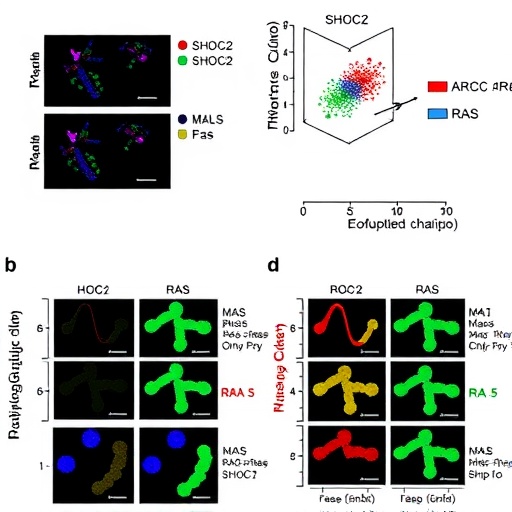
In the relentless pursuit of conquering cancer, targeting the notorious family of RAS proteins remains a formidable challenge. RAS mutations, central to the oncogenic transformation in a wide spectrum of cancers, exhibit complex resistance mechanisms that have long thwarted efforts for durable therapeutic success. Recent advancements, however, have illuminated new paths that might finally unravel these intricacies. Groundbreaking research now uncovers a novel vulnerability in RAS-mutant cancers by pinpointing the interaction between SHOC2 and RAS proteins as a promising therapeutic target.
RAS proteins, small GTPases that toggle between active and inactive states, orchestrate key signaling cascades governing cell proliferation and survival. Mutations in RAS—most commonly in KRAS, NRAS, and HRAS isoforms—impair their GTPase activity, locking them in an active state that drives uncontrolled oncogenic signaling. Remarkably, not all RAS mutations confer identical biochemical behaviors or therapeutic susceptibilities. Recent studies employing isogenic cell models have revealed that distinct RAS mutants, such as G12C/D and Q61R variations, display unique dependencies on upstream and downstream effectors, highlighting the necessity for mutation-specific therapeutic strategies.
Traditional RAS-targeting agents increasingly face resistance, partially driven by adaptive mechanisms like the upregulation of RAS protein levels and alternate pathway activation. This has propelled interest towards orthogonal approaches, focusing on components intricately linked to RAS signaling rather than RAS directly. In this context, the SHOC2 protein emerges as a critical facilitator of RAF kinase activation, acting within the SMP complex that comprises SHOC2, MRAS, and PP1C, a phosphatase complex essential for dephosphorylating inhibitory sites on RAF kinases.
Intriguingly, SHOC2 acts as a pan-RAF activator by modulating all three RAF isoforms—CRAF, BRAF, and ARAF—overcoming the issue of isoform redundancy that impedes many RAF inhibitors. The redundancy in the RAS-RAF signaling axis presents a notorious obstacle to therapeutic targeting, as inhibitors that fail to address all isoforms often result in transient responses and rapid emergence of resistance. The identification of SHOC2 as a bottleneck node in this signaling network offers an elegant solution, as its inhibition could potentially suppress RAF activity across isoforms, thereby circumventing compensatory escape mechanisms.
The researchers conducted an unbiased genome-wide gene-inactivation screen in RAS-mutant isogenic cell models, unveiling mutant-specific dependencies that segregate clearly between G12 mutants and Q61 mutants. While agents targeting SOS1, SHP2, and IGFR1 showed preferential activity against G12 mutants, RAS(Q61) mutants—especially NRAS-driven tumors common in melanoma and hematologic malignancies—remained elusive to these approaches. Notably, RAF inhibitors, though showing some activity in NRAS(Q61) contexts, have faltered clinically due to limited therapeutic windows and inability to sustain durable responses.
Critically, SHOC2 depletion demonstrated potent killing of RAS(Q61) mutant cells in both in vitro and in vivo settings, paralleling direct RAS targeting effects and establishing SHOC2 as an actionable target in this subset of RAS-driven cancers. This dependence highlights a unique vulnerability, corroborated by detailed biochemical and structural analyses revealing a stable and direct binary interaction between SHOC2 and RAS(Q61) mutant proteins. High-resolution X-ray crystallography provided unprecedented insights into this interaction, revealing that the SHOC2 surface engaging RAS remains largely unchanged despite minor conformational shifts, laying a structural foundation for rational drug design efforts.
Targeting the SHOC2–RAS interface thus emerges as a compelling therapeutic strategy, enabling the disruption of a critical node that connects upstream RAS signaling to downstream RAF activation. While other components of the SMP complex, such as MRAS and PP1C, present challenges due to tissue-specific dispensability or potential off-target effects stemming from promiscuous phosphatase interactions, SHOC2’s essential role and structural stability position it as a uniquely druggable candidate.
To date, the drug discovery landscape around SHOC2—and leucine-rich repeat (LRR) containing proteins more broadly—has been barren, with a conspicuous absence of small-molecule binders. The intricate topology of SHOC2’s protein surface and the general challenges of engaging LRR domains have slowed progress. Yet, the innovation reported here includes the identification and validation of the first small-molecule SHOC2 binder, an achievement underscored by the structural elucidation of both a cyclic peptide (referred to as compound 4) and subsequent small molecules ((R)-5 and optimized compound 6) bound to SHOC2. These molecules display promising biochemical, biophysical, and cellular activities, charting a course for optimization strategies aimed at improving ligand efficiency, solubility, and pharmacokinetic profiles.
The implications of targeting SHOC2 extend beyond cancer therapy. The persistent GTP-loading of RAS proteins in various RASopathies—developmental disorders characterized by aberrant RAS/MAPK signaling—suggests a broader therapeutic potential for SHOC2 inhibitors. Moreover, preclinical studies demonstrate that SHOC2 depletion synergizes with MEK inhibitors and KRAS(G12C) inhibitors, offering a promising combination strategy to overcome adaptive resistance. This is particularly relevant as resistance mutations involving RAS(Q61*) residues arise in patients treated with KRAS(G12C) inhibitors, and increased SMP activity has been linked to YAP-mediated adaptive resistance mechanisms.
While promising, the therapeutic targeting of SHOC2 will demand rigorous evaluation of efficacy and safety in integrated preclinical and clinical studies. The balance of pathway inhibition required to achieve therapeutic benefit without eliciting intolerable on-target toxicities remains a critical challenge, as history with MAPK inhibitors attests. Nevertheless, the tolerability of SHOC2 depletion in adult mice and the specificity of its interactions with RAS(Q61*) mutants provide a hopeful outlook for the development of SHOC2-targeted agents.
The convergence of structural biology, chemical biology, and functional genomics within this study exemplifies the power of multidisciplinary approaches to unlock new avenues in oncology. The solved crystal structures of the SHOC2–RAS complexes not only validate the mechanistic underpinnings of previously hypothesized interactions but also furnish valuable templates to guide the rational design of next-generation inhibitors. The identification of lead compounds with measurable cellular activity represents a pivotal milestone in the quest to drug previously ‘undruggable’ protein interfaces.
As the field advances, the therapeutic landscape for RAS-mutant cancers may be transformed by agents that operate through orthogonal mechanisms like SHOC2 inhibition. This approach sidesteps the inherent challenge of directly targeting mutant RAS proteins themselves, which has historically been deemed intractable for most isoforms and mutant types. It also promises to tackle the redundant signaling circuitry and adaptive resistance that have plagued monotherapy strategies, potentially delivering more sustained and durable anti-tumor responses across a difficult-to-treat patient population.
In summary, the elucidation and targeting of the SHOC2–RAS interaction herald a new frontier in cancer therapeutics. By exploiting a crucial node that governs RAF activation and overcoming isoform redundancy, researchers have illuminated a novel vulnerability in RAS-mutant cancers, particularly those harboring NRAS(Q61*) mutations. These insights not only catalyze drug discovery efforts but also reinforce the imperative of precision medicine tailored to specific oncogenic mutations and pathway dependencies. The path from bench to bedside remains challenging yet promising, with SHOC2-targeted therapies poised to enrich the armamentarium against cancers driven by one of the most elusive oncogenic families.
Subject of Research: Targeting the SHOC2–RAS interaction in RAS-mutant cancers as a therapeutic strategy.
Article Title: Targeting the SHOC2–RAS interaction in RAS-mutant cancers.
Article References:
Hauseman, Z.J., Stauffer, F., Beyer, K.S. et al. Targeting the SHOC2–RAS interaction in RAS-mutant cancers. Nature (2025). https://doi.org/10.1038/s41586-025-08931-1
Image Credits: AI Generated
Tags: adaptive resistance in RAS-targeted therapiesisogenic cell models in cancer researchKRAS NRAS HRAS isoformsmutation-specific cancer treatmentsnovel vulnerabilities in RAS-mutant cancersoncogenic signaling pathwaysRAS GTPase activityRAS mutations in cancerRAS protein targetingresistance mechanisms in cancer therapySHOC2-RAS interactiontherapeutic strategies for RAS cancers





